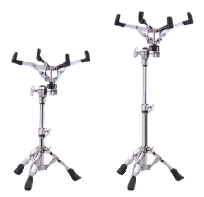In order to practice effectively, it is important to concentrate on each other's sounds and the teacher's words. To do this, all members must be quiet during practice. If there are students who are moving around or talking to each other while other parts are playing, the other members will not be able to concentrate. Some students are not aware that they are making disturbing sounds.
If necessary, practice being quiet for a certain period of time (for example, by deciding how many beats to stay still with a metronome

). It is also important to teach quietness.
It is important to explain the posture when playing, but if you can show each instrument being played on video, you can also teach the atmosphere and tone of each instrument at the same time.
Especially snare drums is determined by the position (height) of the instrument.

There are snare drum stands for seated playing (used with drum sets, etc., on the left) and for standing playing (on the right).
When playing standing up, I often see students using a stand for seated playing, and the instrument is not raised high enough (the head is about one fist below the belt).
If your school does not have a stand for standing playing, please play while sitting. There is no need to play the snare while standing.
Check the type of stand and adjust the position of the instrument to suit the student's height.
It is better to teach the student to do this by themselves.
For instruments that its height cannot be changed, such as keyboard percussion and pedal timpani, have the student stand on some sort of low platform to adjust the position of the mallet and the instrument.
Be sure to give each student a
fingering chart and teach them to memorize it as soon as possible.
It is the student's responsibility to memorize the fingering, but it is the teacher's responsibility to give them the fingering chart.
・How to read music (especially bass clef)
Whether students can read music is an important issue that affects the content of practice and the completion of the piece. If they can read music, new practice tasks can be incorporated one after another. Do not make students who cannot read music, memorize each part and play together. If it takes too long to practice one piece, students will lose interest.
Teach them to read music before (or in parallel with) practicing their instrument.
<8. Before practicing your instrument >
 ). It is also important to teach quietness.
). It is also important to teach quietness.  ). It is also important to teach quietness.
). It is also important to teach quietness.  There are snare drum stands for seated playing (used with drum sets, etc., on the left) and for standing playing (on the right).
There are snare drum stands for seated playing (used with drum sets, etc., on the left) and for standing playing (on the right).